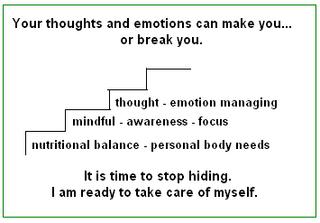
Today I went back to workout at the local YMCA. It's been many years for me, and it has been on my mind for quite a long time. As I examined my procrastination, I came to believe that it was a scheduling time-thing, and with a bit of subconscious mind programming, I was able to readjust my daily schedule so as to fit this in on a regular basis. However, today I couldn't help but notice how nervous I was about beginning. I had lots of thoughts in relation to this fear, as well as breaking my old lifestyle behaviors and patterns. I thought I'd share part of my book that addresses this kind of thing. I actually utilized this for myself today.
There are many areas of lifestyle behaviors that are on automatic pilot. The areas in the above box represent only a few. It helps to imagine that each automatic pilot area has a separate folder in your subconscious mind. As you work with your personal assessment, you will be opening these folders and researching the many aspect of the automatic pilot programming. Some aspects may need to be deleted, changed or mind-edited in some way. Other parts may appear to be fine, but it's a good idea to review these anyway. Your subconscious librarian may have suggestions to make these even better than before.
We all tend to think within certain boundaries, but unfortunately when we do so, our innate creativity can be curtailed. Practice allowing your mind to open and flow. Your subconscious mind will apply this to other areas of your life Each time you encourage creative thinking. Very soon you will find yourself doing so on automatic pilot, and this is a great creative self-gift.
While automatic pilot has some benefits, it also has drawbacks. When you are not fully awake, you give up your rights to observe, assess and manage your thought processes. Thoughts are goals. Whatever you play in your mind becomes your goal for that moment. If you decide to brush your teeth, you will most likely participate in an automatic pilot program designed for oral hygiene. While this may be a safe, automatic mind program for you, suppose that you have a tendency to over-brush, therefore injuring your gums. Since this type of continuous abrasion can lead to some serious gum problems, you will want to dismantle your old automatic program.
MIND EXERCISE
As you practice heightened awareness, you will be able to edit many of these subconscious mind programs, allowing them to better serve you and your desired outcomes. If any of these come to mind now, make a note of them in your journal. Consider them awareness gifts from your subconscious mind librarian.
You can actually encourage these to surface. Here’s how to do that. Relax into the chair where you are reading this. Sense the chair pulling your gently down. Pay attention to what you are reading. You are currently in the process of reviewing and perhaps editing lifestyle behaviors. Notice if you are managing any addictions or if there is disorder in your life. Perhaps you binge on food or some other substance. Ask yourself if any of your automatic programs are blocking your goals for a healthy life.
Notice if you are wearing a belief coat that no longer fits, or one that you never wanted in the first place. Notice that you can edit or correct whatever you choose. Take your time in this moment. Your subconscious mind may send some suggestions now, or later, but your questions will be answered. You can ask questions in the forms of words or through imagery. Place an image or an idea on your mind screen and how to achieve this. It’s as simple as that.


